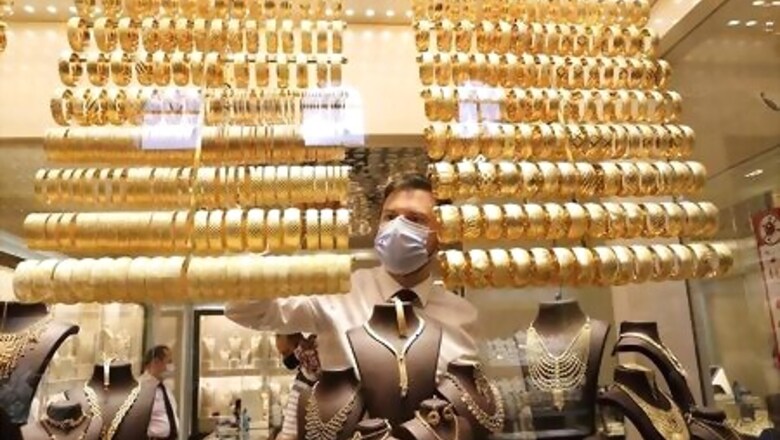
views
ISTANBUL Hasan Ayhan followed his wife’s instructions last week and took their savings to buy gold at Istanbul’s Grand Bazaar as Turks scooped up bullion worth $7 billion in a just a fortnight.
With memories of a currency crisis which rocked Turkey’s economy only two years ago fresh in his mind, the retired police officer was among those playing it safe as he queued in the city’s sprawling covered market, where a screen showed the gold price rise by one Turkish lira ($0.1366) in just 10 minutes.
“I think it is the best investment right now so I converted my dollars to buy gold,” the 57-year-old said, adding: “I might withdraw my lira and buy gold with it too, but I am scared to go to the bank right now because of coronavirus.”
The day after Ayhan bought his gold on Aug 6, the lira hit a historic low and has remained skittish since, laying bare concerns that Turkey’s reserves have been badly depleted by market interventions, which are showing signs of fizzling out.
Turks have traditionally used gold as savings and there may be as much as 5,000 tonnes of it “under mattresses”, with more added after the recent buying spree, Mehmet Ali Yildirimturk, deputy head of an Istanbul gold shops association, said.
Although bullion has never been more expensive, vendors at the Grand Bazaar said almost no one is coming to sell their gold jewellery. There are only buyers.
“I’ve been chatting with hundreds of people who are thinking about selling their cars or houses to invest in gold,” Gunay Gunes, whose busy booth is near the market’s entrance, said.
In the last three weeks, as selling gripped the lira, local holdings of hard assets such as dollars and gold jumped $15 billion to a record of nearly $220 billion.
There is no evidence suggesting people are about to pull savings from banks, and this week the lira has hovered around 7.3 versus the dollar, although it remains among the worst emerging-market performers this year.
Demand has eased since Turks withdrew some $2 billion in hard foreign cash from their banks during a March-May period in which a lockdown was imposed and the lira hit its last low, according to central bank banknote data.
GOLDEN ERA?
Analysts say that if Ankara cannot boost confidence in the currency, which has fallen almost 20% this year, import-heavy Turkey risks inflation and even a balance of payments crisis that will worsen fallout from the coronavirus crisis.
Given foreign investors now have only a small stake in Turkish assets, they say the key for President Tayyip Erdogan’s government is convincing Turks and local businesses to stop turning to the perceived stability of dollars and gold.
The central bank and the Treasury did not immediately comment on the dollarization trend or any policy response.
Meanwhile, Finance Minister Berat Albayrak, Erdogan’s son-in-law, said on Wednesday the lira’s competitiveness is more important than exchange rate volatility.
The central bank has effectively borrowed on local dollar liquidity to fuel its foreign exchange market interventions, which are meant to stabilize the lira, according to data and the calculations of traders and economists.
Through Turkish state banks, which together are “short” foreign exchange by $12 billion, the central bank has sold more than $110 billion since last year, the data show.
In turn, the bank’s gross FX buffer has fallen by nearly half this year to below $47 billion, its lowest in years.
GRAPHIC-Turks flock to forex while buffer erodes https://graphics.reuters.com/TURKEY-CURRENCY/GOLD/qzjvqwbmbvx/chart.png
The central bank has said its reserves naturally fluctuate in stressful periods, and the Treasury says the bank intervenes at times to stabilize the currency.
But ratings agencies and investors say Ankara should take decisive steps such as an interest rate hike to rebuild reserves and restore confidence. Otherwise, rising current account deficits and possible debt defaults could tarnish a solid reputation for meeting foreign obligations.
These debt repayments are set to rise in October.
“Locals don’t want to keep Turkish lira, they’ve been dollarizing and buying gold. Turks have hardly ever done that historically,” said Shamaila Khan, New York-based head of EM debt strategy at AllianceBernstein, which manages $600 billion.
“That is why you need proactive policies because if you get to that stage where locals are unwilling to keep their money in the bank then you’re heading to a balance of payments crisis. That’s when the alarm bells will start ringing,” she said.
Some banks imposed fees on withdrawals this week, while the central bank has curbed cheap credit channels it had opened to ease the coronavirus fallout.
GRAPHIC-Lira’s value has nearly halved since end-2017 https://graphics.reuters.com/TURKEY-CURRENCY/GOLD/nmovalgznpa/chart.png
FX RISK
Yet while lira deposits now earn more than the 8.25% policy rate, their real return is negative with inflation at 11.8%.
Traders say such backdoor tightening needs to reach 11.25% to stabilize the lira, which has nearly halved in value since early 2018, sowing anxiety over diminished living standards in a country accustomed to free trade and travel.
Market expectations have risen for a formal rate hike that economists say would reinforce central bank independence, even while it could slow economic recovery.
Politics may stand in the way.
Erdogan, whose popularity has dipped in the polls this year, has repeated the unorthodox view that high rates cause inflation and sacked the last central bank governor for disobedience.
He said on Monday he hoped market rates would fall further.
But firms such as System Denim, which imports some materials and makes clothes for foreign companies like Zara and Diesel, are feeling the pinch from rising investment costs.
Owner Seref Fayat said he recently converted his 4% euro-denominated loans to lira at 10%.
“No need to take on additional FX risk,” he said. “Now I pay a higher rate, but at least I can see ahead.”
(For an interactive graphic of rising local forex holdings and falling official reserves, click here: https://tmsnrt.rs/31LL5iNFor a graphic of the lira drop, click here: https://tmsnrt.rs/33UFucF )
($1 = 7.3232 liras)
(Additional reporting by Ceyda Caglayan and Ali Kucukgocmen in Istanbul, Nevzat Devranoglu in Ankara, and Rodrigo Campos in New York; Editing by Alexander Smith)
Disclaimer: This post has been auto-published from an agency feed without any modifications to the text and has not been reviewed by an editor



















Comments
0 comment